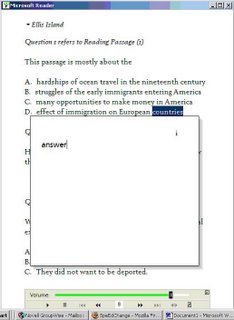

In the search for methods of evaluating whether digital text reading is likely to be the right match for a student, I have started to use the NAEP (National Assessment of Educational Progress) reading samples on both paper and in Microsoft Reader to see the intial impact of the dual-input effect.
I have fourth, eighth, and twelfth grade reading tests on both paper and converted into e-book format, and ask students to work through one set of reading/questions on paper and another using Reader (including typing the answers into Reader's "text note" function).
The results show me a couple of things. First, it's an evaluation of reading against a real standard. Second, the difference between performance on comprehension issues between "ink and paper" reading and digital reading truly illuminates the issues of decoding, because the student is, in both cases working completely on their own.
Though poor readers will probably not have the comprehension skills (honed by practice) to do "much better than expected" when using the digital reader, improvement in the scores does indicate that they are likely to be able to take advantage of what digital reading offers.
The NAEP tests are available here. Microsoft Reader is free but you need to download three parts: The Reader software itself, the Text-to-Speech engine, and the "RMR" Word Conversion tool.
And here's the University of Virginia's e-book library.
No comments:
Post a Comment